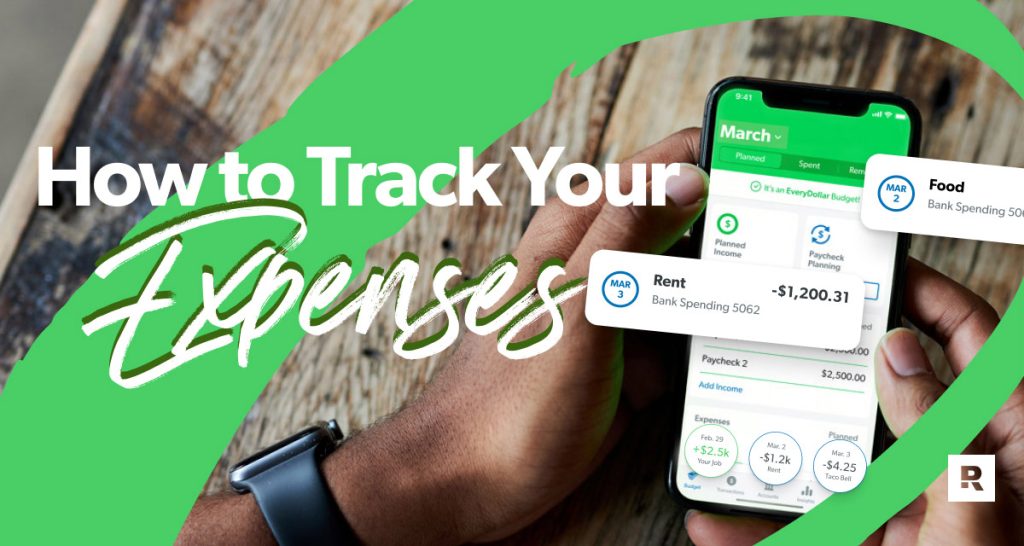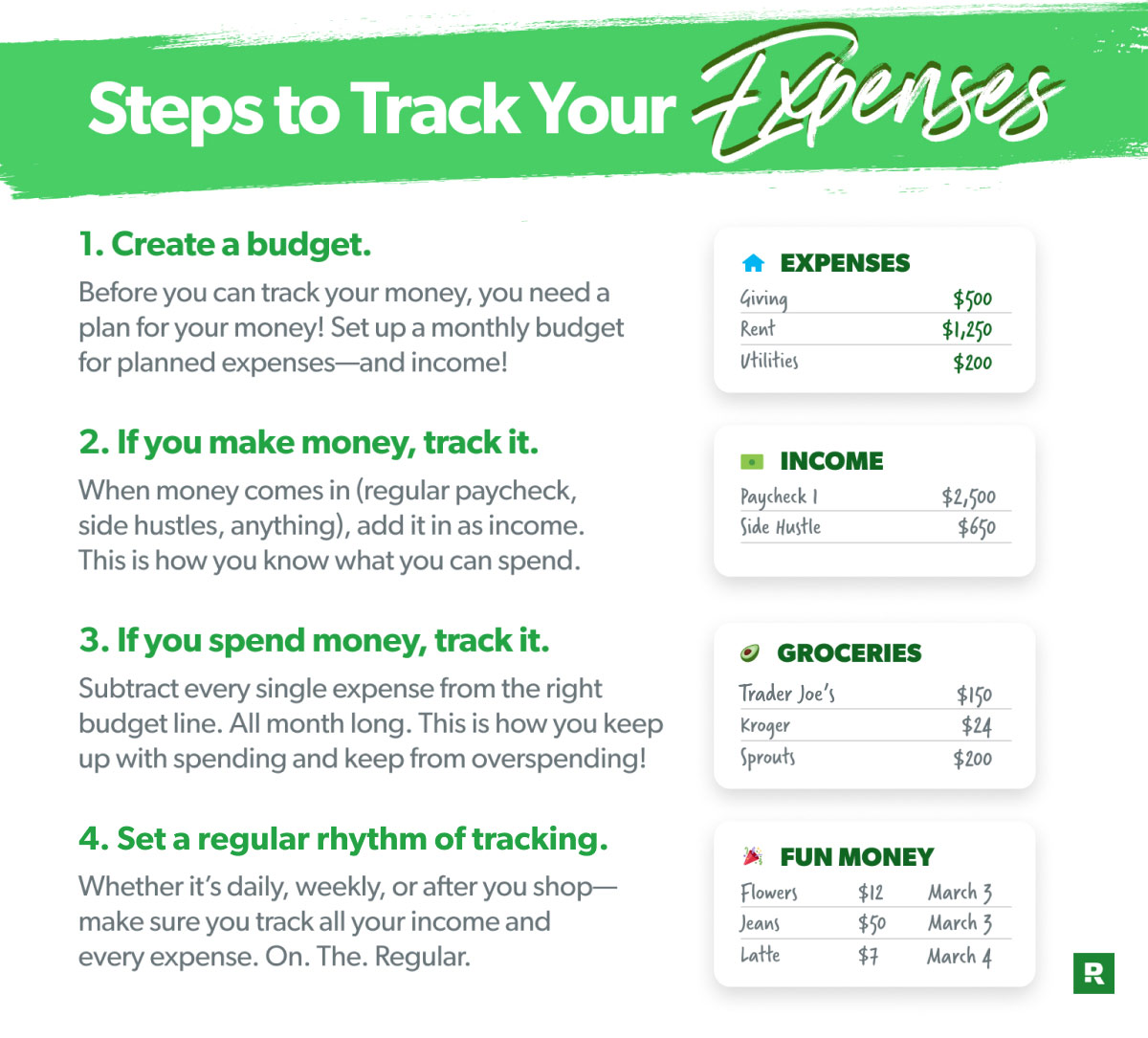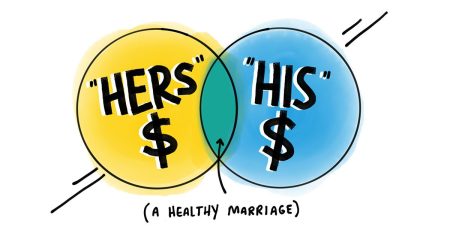If you want to win with money, you’ve got to change your actions with money. The way you do that is by making a budget and sticking to it. And the way you do that is by tracking expenses.
This is the secret to taking your budget from good intentions to awesome outcomes. So, let’s talk about how to track expenses in four simple steps.
How to Track Expenses in 4 Simple Steps
Tracking expenses (aka tracking transactions) isn’t hard—it’s a habit. And just like other important habits (you know, like flossing), it takes some work and repetition to go from trying to remember to do it to doing it naturally. But you’ll get there. And your teeth—and budget—will thank you. Just follow these four steps.
Step 1: Create a Budget
You won’t be able to track expenses without one. What’s a budget? It’s your monthly money plan. When you budget, you give every dollar that comes in during the month a job to do, whether that’s giving, saving or spending.
And listen, budgets get a bad rap. Has anyone ever told you a budget is too limiting? The truth is, a budget doesn’t control you—you control it. It’s a guide you set up to make sure your money does what you tell it to do. So, it actually gives you permission to spend!
Also, if you’re worried about how much work is involved in budgeting, check out EveryDollar! This free app helps you make (and stick to) your budget with ease.
Okay, here’s how you go about setting up a budget:
1. List your income.
List out all the money you plan on making this month. (That means your regular paychecks and any extras like that side hustle!) Add it all up. This is how much money you have to work with this month!
Got an irregular income? Just look back at what you’ve made the last few months. List the lowest amount as this month’s planned income. We’ll talk more about this in a moment.
2. List your expenses.
Time to plan for everything you’re paying for this month. List your expenses in this order:
- Giving (10% of your income)
- Savings (depends on your Baby Step)
- Four Walls (food, utilities, shelter/housing and transportation)
- Other essentials (insurance, debt, childcare, etc.)
- Extras (entertainment, restaurants, etc.)
3. Subtract your expenses from your income.
This should equal zero. If you’ve got money left over, that’s awesome! Put it toward your current Baby Step (the proven, guided path to saving, paying off debt, and building wealth). If you’ve got a negative number, lower your planned totals or cut extras until you get zero.
This is called zero-based budgeting, and as we said before, it’s all about giving every single dollar you make a job to do. That way, your money’s working as hard as you do.
Now that you’ve set up your budget, you’ve got to keep up with it. That’s where the tracking comes in!
Step 2: If You Make Money, Track It
When your regular paycheck comes in, enter that amount in the income part of your budget. If you make money through a side hustle or you sell something, log that in too!
This step is super important if you have an irregular income. Remember, you planned low when you listed your income. So, if your income turns out to be more than you planned, now’s the time to adjust. You can add money to your current money goals or cover some extras in the budget.
Even with a regular income, track it! For one thing, you can make sure nothing’s off with your paycheck. For another, it’s one more way to get you in your budget (which is always a solid win).
Step 3: If You Spend Money, Track It
Track every single expense you make. All month long.
Start budgeting with EveryDollar today!
When you fill up the gas tank, subtract that expense from your transportation budget line. When you pay the rent, subtract that expense from your housing line. When you buy tickets to see your favorite boy band’s reunion tour, subtract that expense from entertainment.
You get the picture. If money’s coming out of your wallet, bank account, PayPal, cash envelope, coin purse or old-fashioned piggy bank—track it.
As you’re tracking, make sure you’re subtracting too. Then you can see how much you have left in your different budget categories. This is where the magic happens—because this is how you keep up with spending so you can keep from overspending!
Step 4: Set a Regular Rhythm for Tracking
Track your expenses regularly. That might be weekly, daily—or before you leave the grocery store parking lot.
Whatever works for you and gets every expense tracked with no paper receipts getting lost in that kitchen drawer that must be some kind of portal to another world. (How else do you explain the things that go in but never come out?)
If you’re married, make sure you’re both working from the same budget and tracking expenses. This is great for accountability and communication. That way, neither one of you will ever say, “I didn’t know you spent most of the entertainment budget on ziplining tickets. I wanted to sign us up for a couples hip-hop dance class.”
4 Ways to Track Expenses
1. Pencil and Paper
Don’t dismiss old-school methods. Plenty of people love a good paper budget as their money-tracker method.
Pros
- You don’t need access to technology.
- Physically writing things down requires an active brain. (And active brains are really helpful when you’re dealing with money.)
Cons
- It’s a lot to constantly write down and keep up with the math like this.
- If you misplace receipts, mix up your numbers, or forget to record some spending, that can lead to a busted budget.
Conclusion
Hey, budgeting with pencil and paper is way better than no budget at all. If it’s the only way you want to go, then go for it! Also, if you want to start out on a paper budget and then move on to some other method, check out our Quick-Start Budget.
2. Envelope System
The envelope system focuses on paying cash for as many things in the budget as you can. You can autodraft expenses like retirement contributions, mortgage payments and some utility bills, and you might send checks or make a debit card payment online for other bills. But you’ll stick to cash for all the expenses you pay for in person.
So, at the start of the month, label some envelopes (or use a special divided wallet) with the budget lines you want to pay for in cash. (Groceries, entertainment and restaurants are three examples.) Then, fill each envelope with the amount of money you budgeted for that particular line.
Pros
- You know exactly when to cut back on spending because you see when the envelope starts getting low.
- You don’t overspend because when the envelope is empty, you’re done spending. (Your money is essentially tracking itself!)
Cons
- Sometimes paying in cash is inconvenient.
- With the rise of e-commerce, paying cash isn’t always an option.
Conclusion
Physically watching the money leave the envelope inspires a whole new level of responsibility. Even if you go with a different method for tracking your expenses, doing the envelope system with some of your budget lines is a great way to manage your money.
3. Computer Spreadsheets
It’s time to talk digital—computer spreadsheets as an expense tracking method.
Pros
- Spreadsheet enthusiasts love the tons of template options.
- You can customize your budget.
- Once you set it up, the math is done for you.
Cons
- Spreadsheet enthusiasts aren’t always married to fellow spreadsheet enthusiasts. This can cause some friction in the money and marriage department.
- Having to physically get to your computer every time you need to track a transaction can be super inconvenient. And if you aren’t making regular visits to enter expenses, your budget isn’t really a budget—it’s just a spreadsheet full of plans.
Conclusion
Again, if spreadsheets are the only way you want to budget and handle your expense tracking, that’s better than skipping budgeting completely!
4. Budgeting Apps
We love a good budgeting app. Seriously. Most of us have our phones on us at all times—which means we can have our budgets on us at all times! Brilliant.
Pros
- It’s. So. Convenient.
- You can log in on your phone and track the expenses immediately, no matter where you are.
- Budgeting apps usually have loads of features to help you create your budget and keep up with your money.
- Sharing the same budget with your spouse is super easy.
Cons
- You need access to technology.
- The company who made your app could shut it down, and your budgeting history would be gone (like the recent Mint situation).
Conclusion
If you aren’t watching where your money’s going, you’ll always wonder where it went. Budgeting apps make it way easier to stay on top of spending so you can move beyond good intentions into financial victories.
Get an Expense Tracker and Track Your Expenses (Every Single One)
Okay. You’ve seen the why and the how and the popular methods for money tracking. Now it’s time to get on it.
The number one thing here is that you should budget, which includes tracking expenses. You need a budgeting method that keeps you accountable and in control—while also being simple enough to stick with!
That’s why we can’t say enough about EveryDollar. Our app makes it easy to set up your monthly budgets and track your expenses (every single one).
Because that’s how you’ll know where your money is really going. That’s how you’ll start setting realistic budgets and hitting your money goals. Plus, it’s an app created by a company with budgeting at its core. (Aka it’s not going anywhere.)
Tracking expenses is the secret to budgeting well. And now that it’s not a secret, you can make it happen!
Read the full article here











